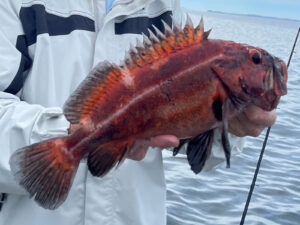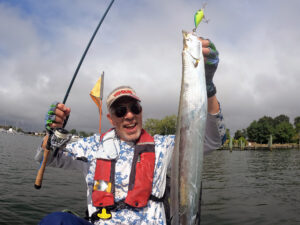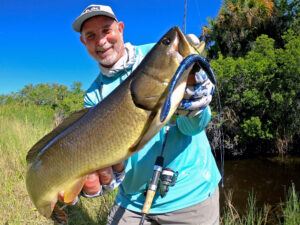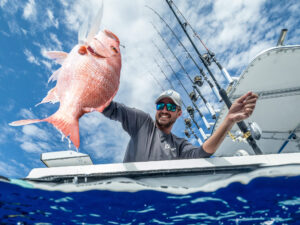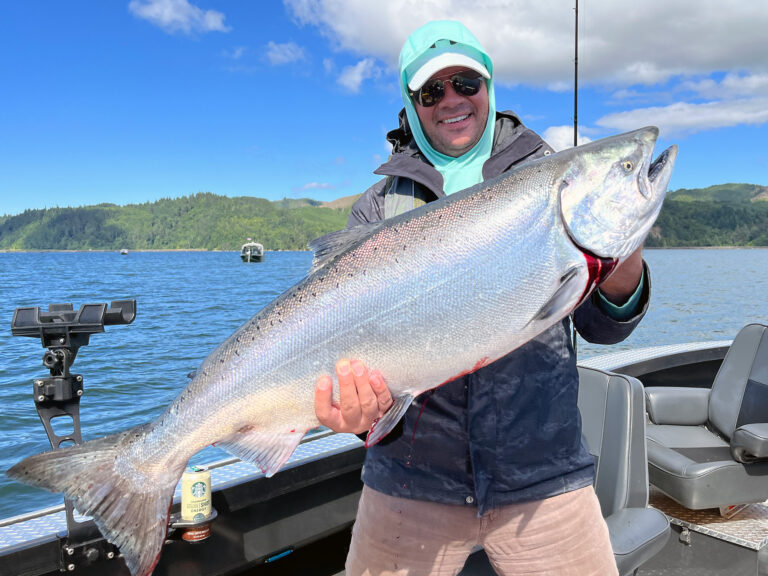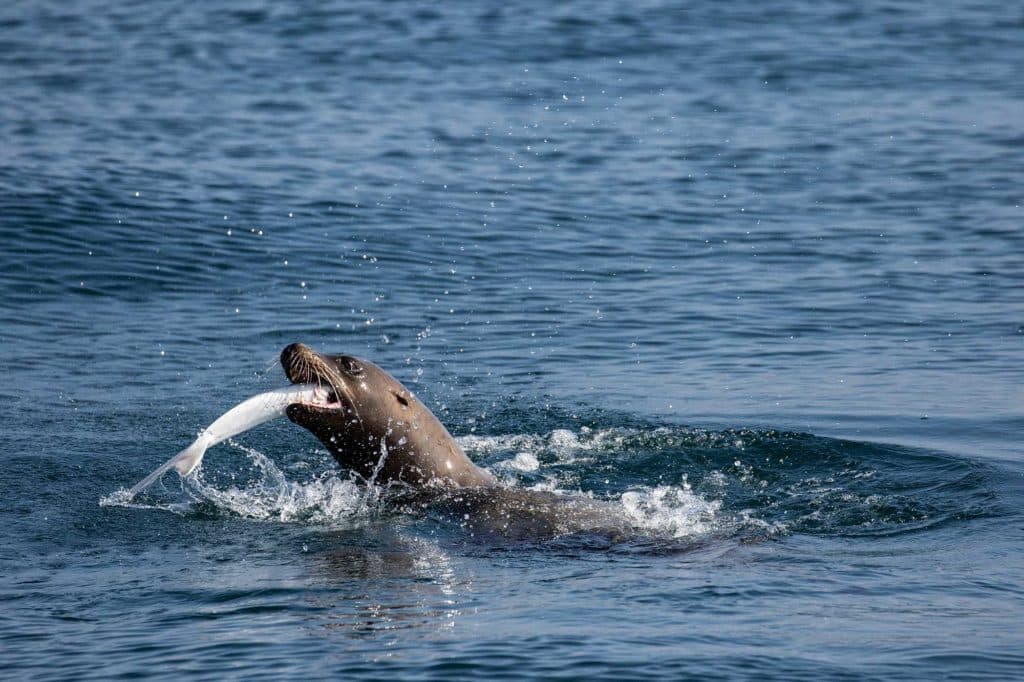
West Coast anglers abhor sea lions — with good reason. These clever pinnipeds, adored by the general public for their cute tricks and clownish behavior at theme parks such as SeaWorld, learned long ago to follow sport-fishing boats, like so many kids running after ice cream trucks. It’s not ice cream that sea lions crave. Instead, they slurp up chum, snatch live baits and grab onto hooked fish, and eat those released. Some sea lions even leap aboard boats to steal fish. That’s what happened to Dan Carlin in April 2015. But Carlin suffered more than the loss of a fish. The San Diego angler was posing for a photo with a California yellowtail on his boat in Mission Bay when a big, aggressive California sea lion jumped into the boat and bit into the yellowtail in the same exact place where Carlin’s left hand was holding the fish. His wife, Trish, captured that very moment on camera.
The story does not stop there. The sea lion fell back into the water, maintaining its grip and dragging the yellowtail — and Carlin — over the side and underwater. After about 20 seconds, the sea lion let go of the angler, but then bit Carlin on the foot as the angler swam for the boat. He spent two days in the hospital, receiving a strong dose of antibiotics and 20 stitches to close the wounds.
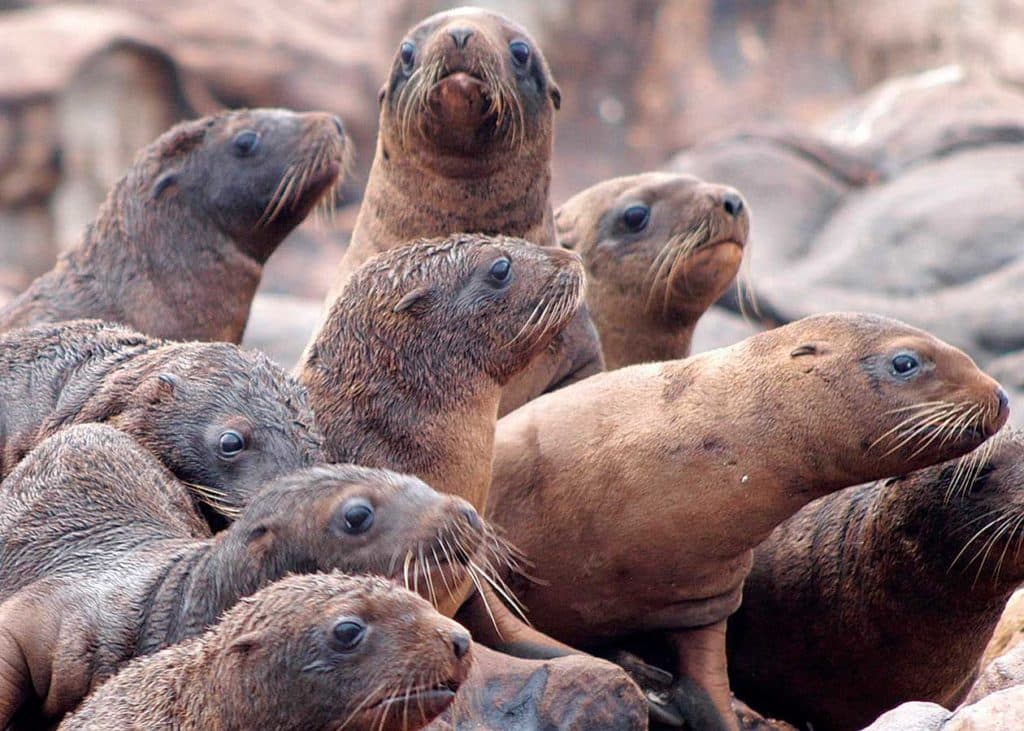
Protection Program
This is the West Coast sea lion scourge in the extreme. And it seems to be getting worse. That’s because populations of sea lions have exploded, thanks in large part to the Marine Mammal Protection Act. This federal law was passed in 1972 to help avert decimation and help rebuild populations of marine mammals in all territorial waters of the United States. It protects porpoises, whales, sea otters, seals and, yes, sea lions.
The good news is that the MMPA worked. In the past 46 years, a number of marine-mammal species have rebounded nicely, especially the population of the California sea lions. But many anglers contend that the ever-expanding population of these marine mammals has thrown the West Coast marine ecosystem out of balance.
Fishermen seethe with contempt for these animals, which can reach 860 pounds. “We need to start killing them to control the population,” says Dave Hanson, a fishing guide based in California’s Dana Point Harbor. “Otherwise, they will continue to ruin fishing for everyone.”
Researchers find it difficult to count the actual number of sea lions, says Charles Villatana, fisheries biologist for the National Marine Fisheries Service West Coast observer program.
“Instead we survey the number of pups born at established California sea lion rookeries during each breeding season,” Villatana explains. “This serves an indicator of population trends.”
Read Next: Bill Protecting Northwest Salmon Passes Senate Committee
When the MMPA was enacted in the ’70s, about 12,000 pups were born each year, according to data from the NMFS. In past decades, the birth rate has spiked up and down, including a big dip in the late ’90s. Yet, on average, pup counts have increased by 5.4 percent annually between 1975 and 2008, NMFS data indicates. By 2011, the pup count had swelled to more than 60,000. Today, NMFS population estimates hover around 250,000 to 275,000 California sea lions and 71,000 Steller sea lions.
The MMPA is not the sole reason for the boom in California sea lion populations. Lack of predation plays a role. Apex predators, primarily great white sharks, might ordinarily help hold sea lion populations in check.
However, great whites suffered from overfishing along the West Coast in the 1970s and ’80s, and this led to a scarcity of these sharks, which in turn allowed sea lion numbers to expand. In 1994, great whites received legal protection in California, and there is now evidence indicating that the numbers are rising. In central California, for example, researchers are tracking at least 2,400 adults along the coast and offshore islands. Burgeoning sea lion populations help sustain adult great whites and fuel the population growth of this shark species.
Meanwhile, sea lions have become particularly annoying for those fishing along the coast of Southern California and its offshore islands such as Santa Barbara, Santa Catalina and San Clemente. But these aren’t the only places. Salmon anglers in the Columbia River routinely lose hooked salmon to aggressive California and Steller sea lions. Here’s how sport fishermen have learned to deal with the problematic pinnipeds, known with disdain as bowsers, dogs and knotheads.
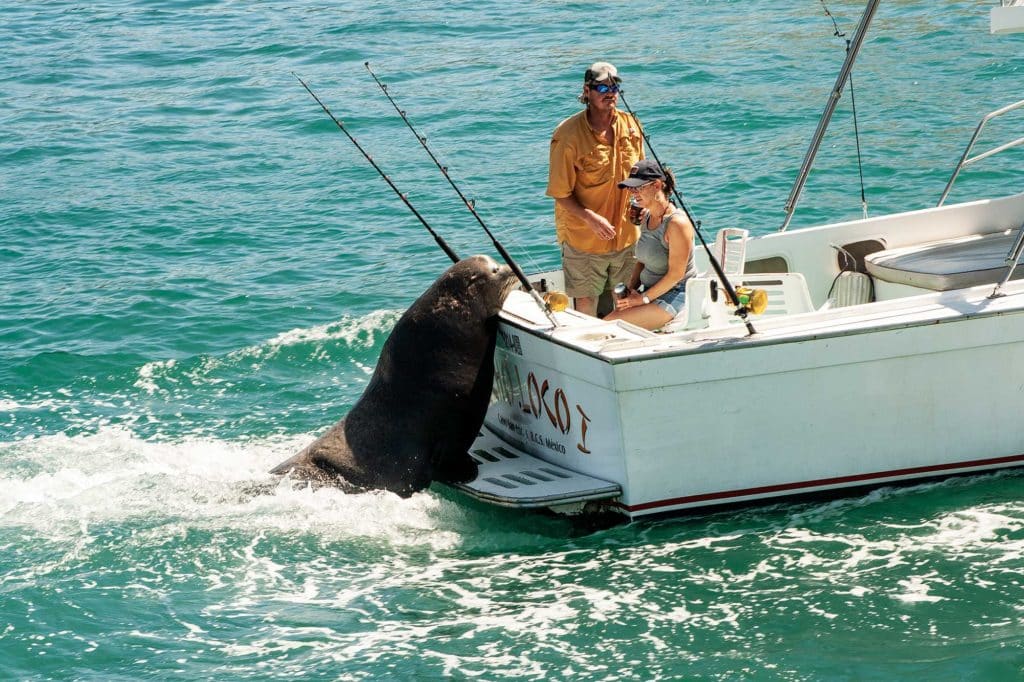
Easy Meals
Remember Yogi the Bear cartoons and the sign that read “Don’t Feed the Bears”? The same applies to sea lions. A big part of the problem is that many of these marine mammals have become habituated to humans, conditioned to associate people and man-made objects with easy meals. Many tourists feed sea lions intentionally because the doe-eyed animals look cute and cuddly.
However, it’s largely unintentional feeding that draws sea lions to fishing boats. In Southern California, live-bait fishing is very popular, and many commercial passenger fishing vessels (aka party boats) anchor up and chum with live bait such as anchovies and sardines. This is undeniably effective in attracting game fish such as calico bass and California yellowtail, but it also draws in sea lions. The drone of the party boat’s diesel generator and the rattle of the chain as the boat sets anchor serve as lunch bells to the educated pinnipeds.
Sea lions not only gobble down the live chum, but they have also become adept at nipping off hooked baits while avoiding the hook itself. Hungry sea lions also tend to scare away game fish. Anglers quickly grow discouraged when the dogs are cavorting around the boat. It can render even the best fishing spot a lost cause.
“Most days, the sea lions are so thick and persistent, we can’t keep a live bait in the water for more than a minute,” says Hanson, who regularly fishes Santa Catalina and San Clemente islands. “And if we do hook a nice fish, the dogs are on it almost immediately.”
To get rid of the sea lions, some captains play a waiting game, withholding chum and live baits until the offending sea lion goes looking for another boat from which to freeload. Hanson likes to lay all of the fishing rods on the deck, believing that sea lions have learned to equate the sticks with human fishing activity. On other boats, anglers might continue to fish, but with artificial lures, which sea lions fortunately ignore. Once the nuisance is gone, chumming and live-bait fishing can resume.
Move On
Sea lions sometimes refuse to abandon a spot; then, the best course of action is to move to a new location and hope the bowser does not follow. Often, a sea lion will find another boat to harass rather than expend a lot of energy following a boat.
“Many times, you just have to pull up and leave,” Hanson says. “Once a dog fixates on your boat and won’t leave, you’re just wasting bait and your time. It’s an exercise in frustration.”
A new location that’s a fairly long distance from the previous one — at least 3 to 4 miles — prevents the original animal from easily following along. Fast, powerful private boats carry the advantage over slower-moving party boats when it comes to evading sea lions. The pinnipeds find it much easier to tag along with the bigger party boats that cruise at around 12 to 15 mph versus a speedy center-console. Also, party boats put out a lot more food in the form of chum and live bait than do private boats.
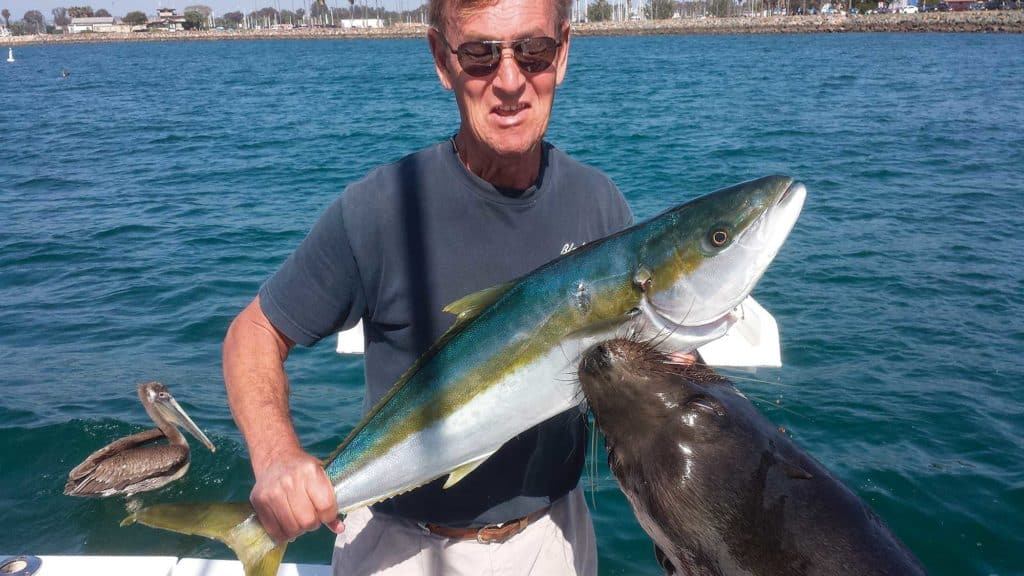
Arm Yourself
Anglers can also employ certain deterrents to scare away sea lions. The MMPA was amended in 1994 to allow for the use of nonlethal means to discourage sea lions from engaging in problematic behavior.
Legal deterrents include visual, audio and physical techniques. On the visual side, the National Oceanographic and Atmospheric Administration website points specifically to boat hazing and circling without striking the animal. Noise deterrents outlined by NOAA include pounding on the hull, pyrotechnics such as underwater firecrackers (known as seal bombs), starter pistols, and horns, bells and whistles.
However, none of these prove highly effective, and can even create the opposite effect. Some boating anglers — particularly those using lights at night to attract schools of market squid for bait — believe that sea lions have learned to equate the distant boom of seal bombs with a dinner bell, and swim toward the sound rather than away.
Physical-contact deterrents work better. Those allowed by NOAA include sling shots, paint-ball guns (with water-soluble, non-toxic paint balls), and nonlethal weapons such as game stingers, sabot rounds and rubber bullets.
However, NOAA frowns on automatic fire due to the increased risk to the public. No live ammunition, sharp projectiles, gaffs, spears, harpoons, nets or poison baits may be used.
To use any of the legal deterrents, anglers must be actively fishing with gear deployed, and sea lions need to be displaying problematic behavior, such as chasing a hooked fish. Also, discharge of firearms is prohibited within most local jurisdictions. So you can’t shoot rubber bullets at a problematic sea lion in the marina.
Even where firearm discharge is allowed, downrange awareness is critical, especially when using rubber bullets with a firearm or firing a powerful pellet gun. The rounds can ricochet off the water and strike another boat and its occupants.
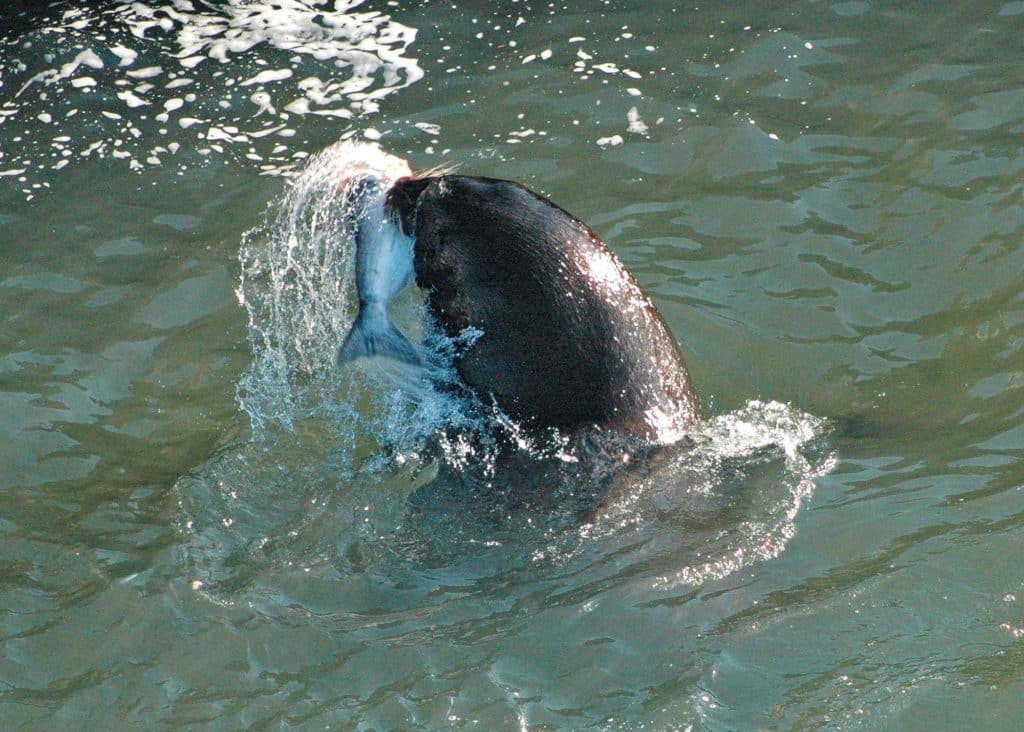
Heavy Tackle
Santa Barbara Island sits some 50 miles off the coast of Southern California. It’s the smallest of the Channel Islands, yet it’s home to a huge California sea lion rookery that hauls out on the beaches of this islet. When yellowtail and white seabass are biting, packs of the pinnipeds take to the water and roam the grounds to pick off fish almost as soon as they are hooked.
On a trip this past summer, my crew and I found a secret to minimizing losses to sea lions: relatively heavy tackle. We fished for California yellowtail with the boat on the anchor, using 65-pound braided line and 40-pound fluorocarbon top shots. With the drags buttoned tight, the powerful yellowtail — which ranged up to 25 pounds in weight — pulled a minimal amount of line. That helped shorten the battles and the time in which a sea lion might have the opportunity to grab the fish.
Also, many of the yellows rocketed from the depths as soon as a sea lion closed in. With the loose line, the yellowtail could easily outrun a sea lion. In the meantime, crewmembers turned the reel handle as fast as possible to catch up. A number of the fish took refuge directly under the hull once they reached the surface, thwarting the sea lion’s attack and making it easy to pull the yellow out from under the boat and gaff it quickly. We did not lose a single fish to sea lions.
The next day, two friends of mine fished the same area with lighter tackle and suffered a high loss ratio to sea lions, which tore away more than 50 percent of their fish.
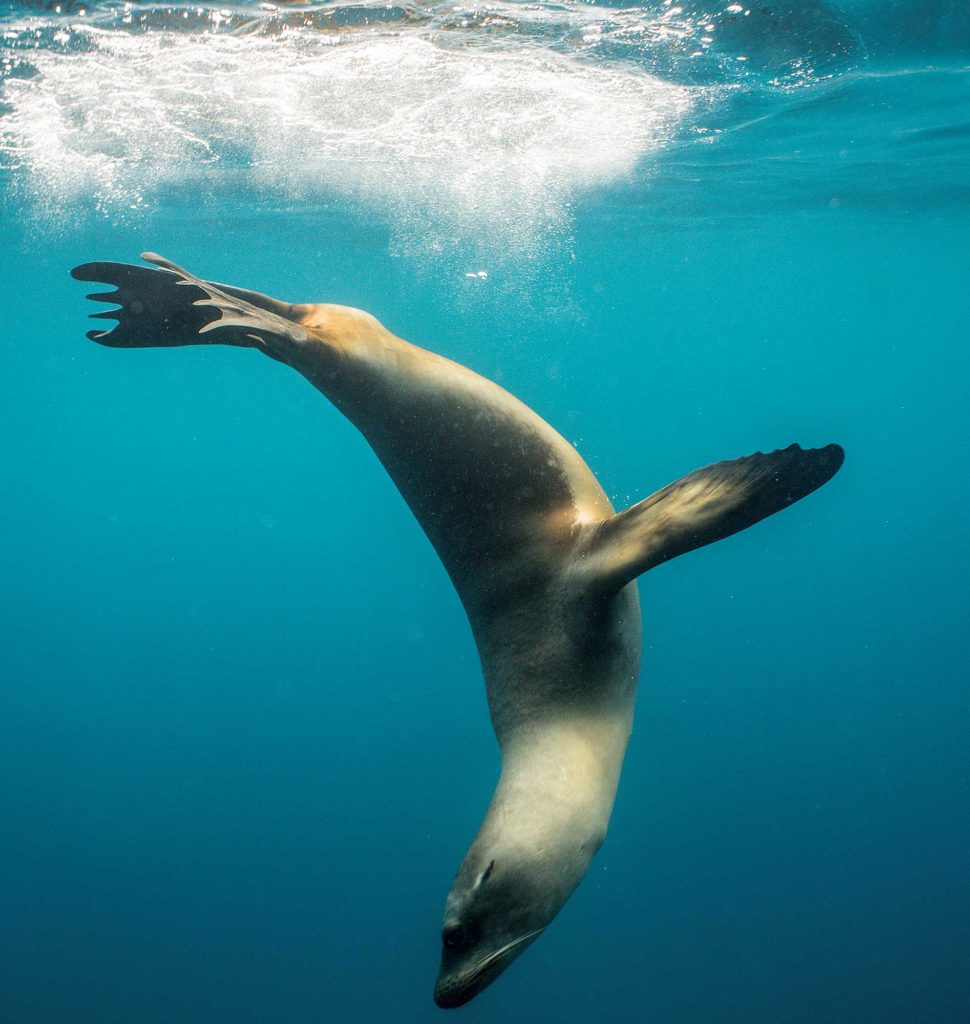
Use a Decoy
A somewhat controversial technique is used by some anglers to keep sea lions away from hooked fish — one that reinforces the sea lions’ association of fishing boats with food but also can keep a sea lion from stealing a nice fish.
In this decoy move, anglers keep a less desirable fish such as a bonito in the fish box. If and when an angler hooks a nice fish such as halibut, yellowtail or white seabass, and spots a sea lion closing in, a crewmember tosses the decoy fish to the animal.
The sea lion will usually divert to the easier meal, ignoring the hooked fish while it tears apart and eats the decoy fish. This also keeps the sea lion occupied at the surface and away from the depths because the pinnipeds cannot swallow food while underwater.
Some sport fishermen criticize this practice because it strengthens a sea lion’s tendency to hang around fishing boats for food, but tell that to an angler who has just hooked a 50-pound white seabass and needs to do everything possible to land the fish of a lifetime. By the way, the decoy fish counts against your daily bag limit under California Fish and Wildlife regulations, even though you fed it to a sea lion.
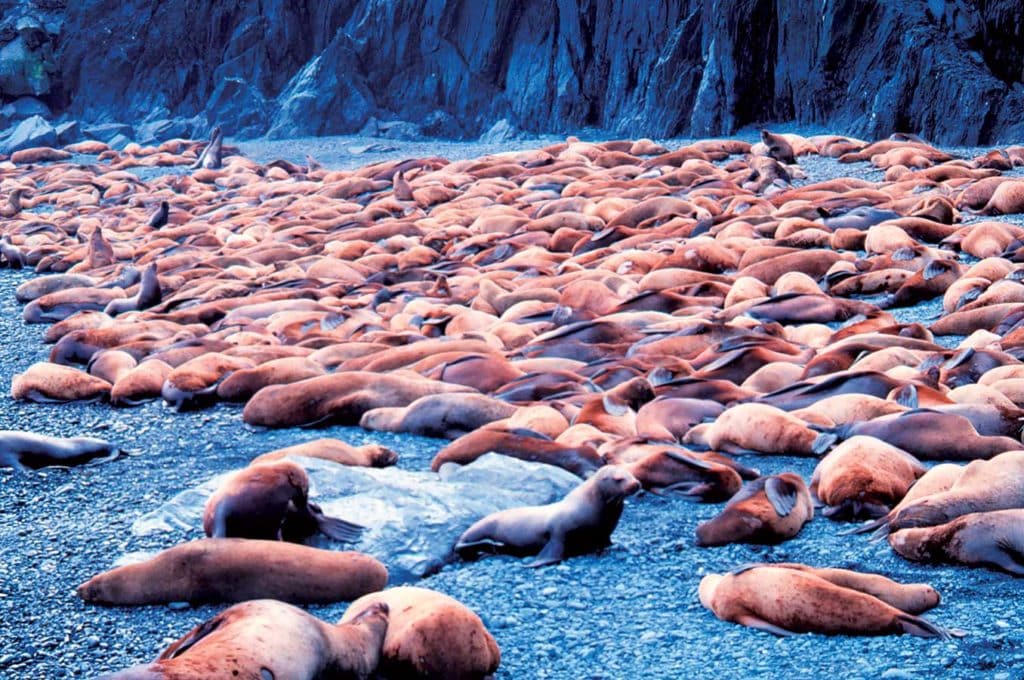
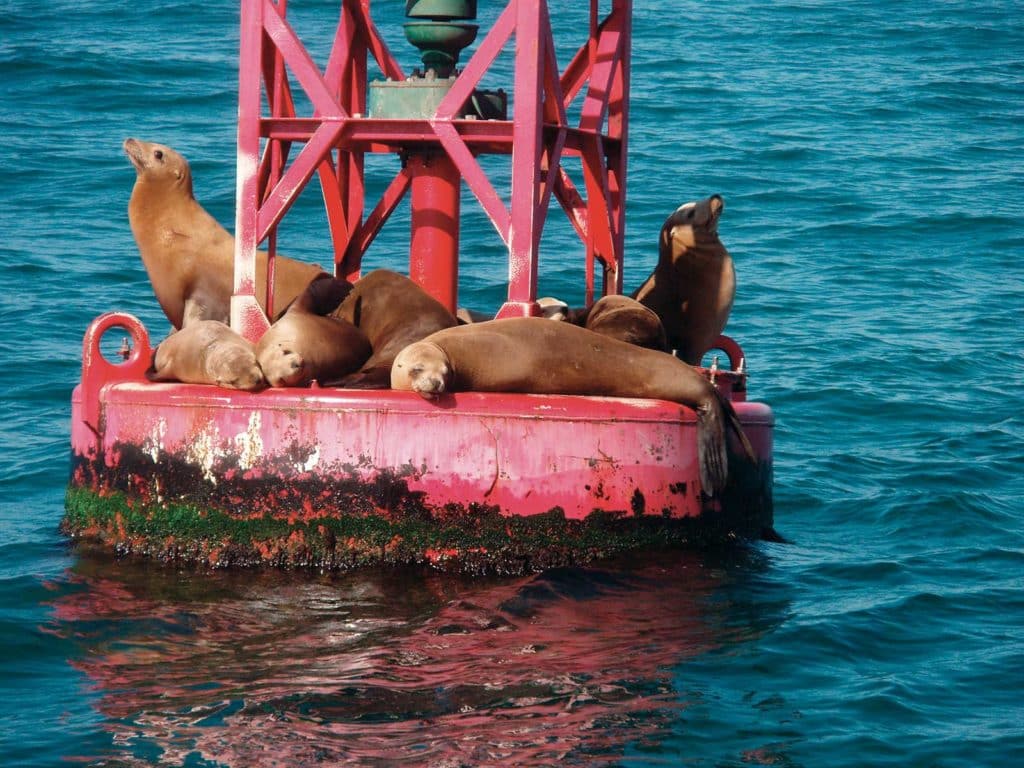
Intercept Move
If your boat is not at anchor, here’s a trick that can help retrieve a fish from the jaws of a sea lion. Follow the sea lion with the boat while the angler maintains steady pressure on the line. Make sure you stay right on top of the animal. The sea lion, being a mammal, will eventually need to surface to breathe, and sometimes it will relax its grip on the fish to take a breath. You need to be there when it happens. Have a crewmember standing by with a gaff to stick the fish as soon as the sea lion surfaces.
Being fast with the gaff is important whenever sea lions are around. Many fish are taken by the animals right beside the boat. Some of these pinnipeds have learned to save the energy of chasing a meal by hovering around the boat until you bring the fish in close, then they dart out and steal your prize. Gaff the fish as soon as it is within reach. Seconds count when sea lions are bent on snatching your catch.
On the West Coast, out-of-balance populations of harassing sea lions will remain a fact of life for many years to come. The best you can hope for is that great white sharks will thin the herd. In meantime, time-tested tricks such as these can help you cope with problematic pinnipeds.

